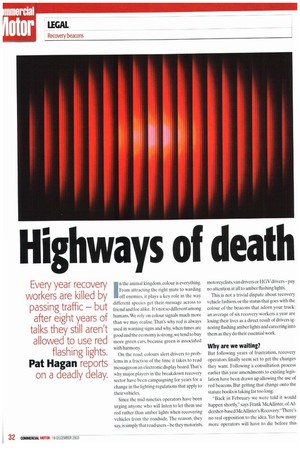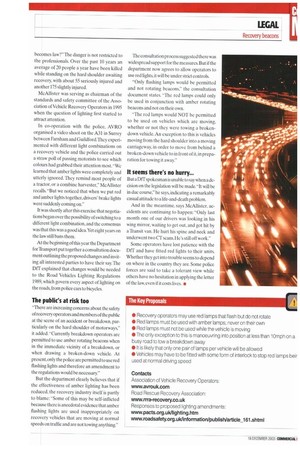Highways of death
Page 32

Page 33

If you've noticed an error in this article please click here to report it so we can fix it.
Every year recovery workers are killed by passing traffic — but after eight years of talks they still aren't allowed to use red flashing lights.
Pat Hagan reports on a deadly delay.
In the animal kingdom, colour is everything. From attracting the right mate to warding off enemies, it plays a key role in the way different species get their message across to friend and foe alike. It's not so different among humans. We rely on colour signals much more than we may realise. That's why red is always used in warning signs and why, when times are good and the economy is strong, we tend to buy more green cam, because green is associated with harmony.
On the road. colours alert drivers to problems in a fraction of the time it takes to read messages on an electronic display board.That's why major players in the breakdown recovery sector have been campaigning for years for a change in the lighting regulations that apply to their vehicles.
Since the mid-nineties operators have been urging anyone who will listen to let them use red rather than amber lights when recovering vehicles from the roadside. The reason, they say, is simply that road users — be they motorists, motorcyclists, van drivers or HGV drivers— pay no attention at all to amber flashing lights.
This is not a trivial dispute about recovery vehicle fashion, or the status that goes with the colour of the beacons that adorn your truck: an average of six recovery workers a year are losing their lives as a direct result of drivers ignoring flashing amber lights and careering into them as they do their essential work.
Why are we waiting?
But following years of frustration, recovery operators finally seem set to get the changes they want. Following a consultation process earlier this year amendments to existing legislation have been drawn up allowing the use of red beacons. But getting that change onto the statute books is taking far too long.
"Back in February we were told it would happen shortly," says Frank McAllister, of Aldershot-based McAllister's Recovery. "There's no real opposition to the idea. Yet how many more operators will have to die before this becomes law?" The danger is not restricted to the professionals. Over the past 10 years an average of 20 people a year have been killed while standing on the hard shoulder awaiting recovery, with about 55 seriously injured and another 175 slightly injured.
McAllister was serving as chairman of the standards and safety committee of the Association of Vehicle Recovery Operators in 1995 when the question of lighting first started to attract attention.
In co-operation with the police, AVRO organised a video shoot on the A31 in Surrey between Farnham and Guildford.They experimented with different light combinations on a recovery vehicle and the police carried out a straw poll of passing motorists to see which colours had grabbed their attention most. "We learned that amber lights were completely and utterly ignored. They remind most people of a tractor, or a combine harvester," McAllister recalls. "But we noticed that when we put red and amber lights together, drivers' brake lights were suddenly coming on."
It was shortly after this exercise that negotiations began over the possibility of switching to a different light combination, and the consensus was that this was a good idea.Yet eight years on the law still bans them.
At the beginning of this year the Department for Transport put together a consultation document outlining the proposed changes and inviting all interested parties to have their say. The DfT explained that changes would be needed to the Road Vehicles Lighting Regulations 1989. which govern every aspect of lighting on the roads, from police cars to bicycles.
The public's at risk too
"There are increasing concerns about the safety of recovery operators and members of the public at the scene of an accident or breakdown, particularly on the hard shoulder of motorways," it added. "Currently breakdown operators arc permitted to use amber rotating beacons when in the immediate vicinity of a breakdown, or when drawing a broken-down vehicle. At present, only the police are permitted to use red flashing lights and therefore an amendment to the regulations would be necessary."
But the department clearly believes that if the effectiveness of amber lighting has been reduced, the recovery industry itself is partly to blame: -Some of this may be self-inflicted because there is anecdotal evidence that amber flashing lights are used inappropriately on recovery vehicles that are moving at normal speeds on traffic and are not towing anything." The consultation process suggested there was widespread support for the measures. But if the department now agrees to allow operators to use red lights, it will be under strict controls.
"Only flashing lamps would be permitted and not rotating beacons," the consultation document states. "The red lamps could only be used in conjunction with amber rotating beacons and not on their own.
-The red lamps would NOT be permitted to be used on vehicles which are moving, whether or not they were towing a brokendown vehicle. An exception to this is vehicles moving from the hard shoulder into a moving carriageway, in order to move from behind a broken-down vehicle to in front of it, in preparation for towing it away."
It seems there's no hurry...
But a DfT spokesman is unable to say when a decision on the legislation will be made. "It will be in due course," he says. indicating a remarkably casual attitude to a life-and-death problem.
And in the meantime, says McAllister, accidents are continuing to happen: "Only last month one of our drivers was looking in his wing mirror, waiting to get out, and got hit by a Transit van. He hurt his spine and neck and underwent two CT scans. He's still off work."
Some operators have lost patience with the DfT and have fitted red lights to their units. Whether they get into trouble seems to depend on where in the country they are. Some police forces are said to take a tolerant view while others have no hesitation in applying the letter of the law, even if it costs lives. •




































































































































































































